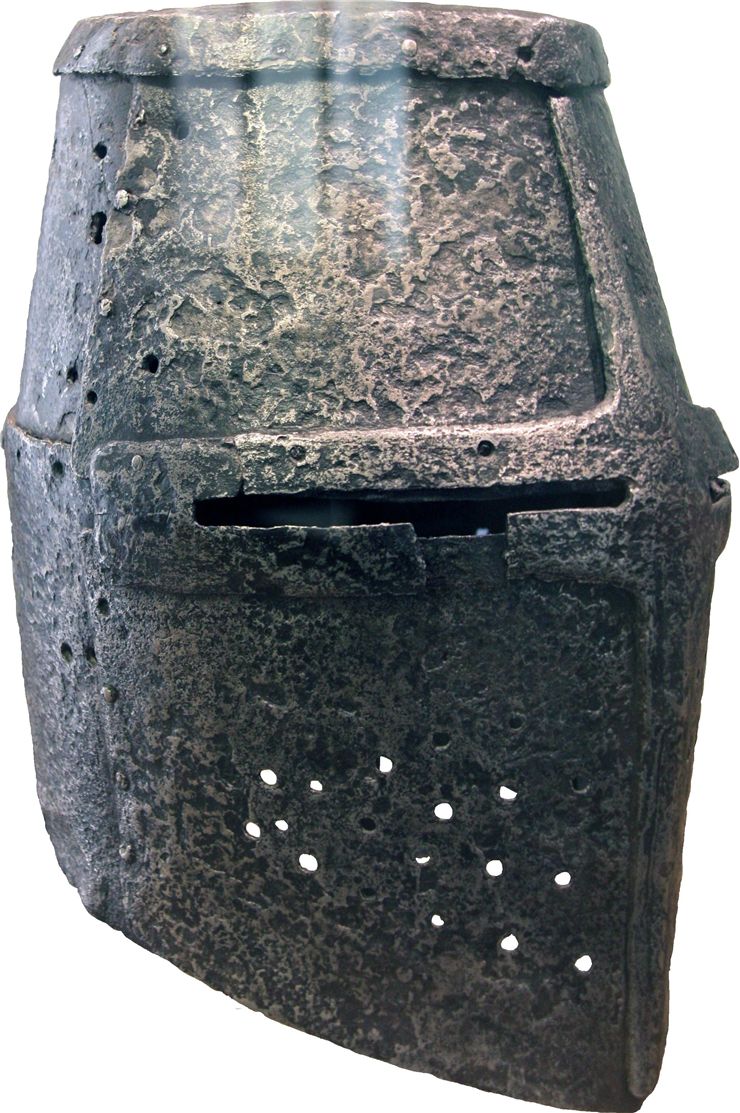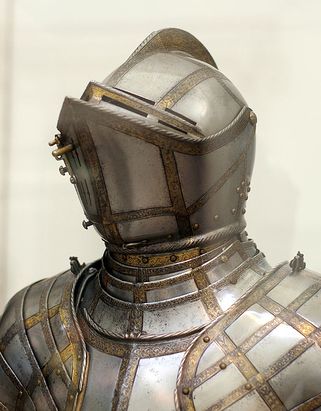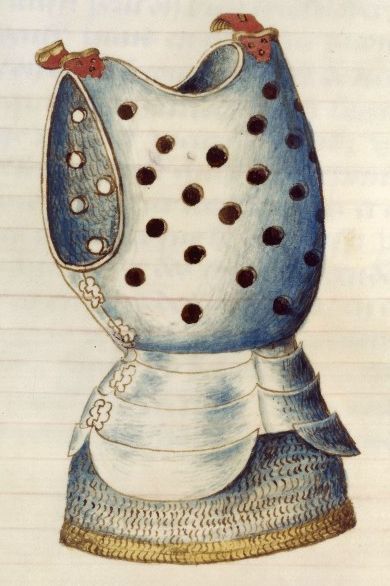Medieval Armor Types and Uses
Medieval times in Europe proved to be one of the richest periods in the time of armor history, with many new and old armor designs being in use and evolved into many interesting ways. Here is a comprehensive list of not only armor sets that were in use during that time, but also closer look at individual pieces that were responsible for protecting users against various types of damage.
Medieval Armor Sets
- Ailette – Short-lived 13th century French leather armor that was focused on placing quadrangular pieces of leather or wood on shoulders and upper arms of the user. Rest of the wearer was covered by full-body chain or ring mail, with lower legs being guarded by metal protectors fastened with leather straps.
- Banded mail – Shortly used metal armor that mixed designs of lorica segmentata and traditional splint mail.
- Bases – Made as an extension of the French cloth military skirts. Its armored version was made from plates, with optional removable back plate so that user can sit on a horse.
- Boiled Leather armor – Very common armor in medieval Europe, made from thick leather that was boiled in oils, waxes and other ingredients. Because boiled leather was brittle, leather was usually cut in smaller pieces and then stitched together for scale or lameral armors.
- Brigandine armor – Brigandine body armor was made from hard cloth (usually canvas or leather) with starched steel plates that were riveted to the inside of the fabric so that from outside only leather is visible.
- Gambeson – Heavily padded leather or canvas armor that was used as body protection both as standalone piece or a base for wearing mail or plate armor. Armors were padded with scrap cloth, horse hair or other components.
- Hauberk – Very finely made shirt made from thin interloping rings of metal that could be worn just as a metal shirt, or interwoven into ordinary shirt or tunic.
- Jack of plate – Very similar as Brigandine that combined small metal plates inside layers of leather shirt, but with this armor, pieces were sown and not riveted.
- Jazerant – Light armor that placed mail armor between the layers of leather or fabric. It was mostly used in Middle East, Persia and Asia.
- Kasten-brust armor – German type of plate armor that was used mostly in 15th century, but was highly popularized by the later paintings in Renaissance.
- Lamellar armor – Armor made from laced pieces of hard leather, iron or bronze plates, used mostly in Eastern Europe and Asia.
- Laminar armor – Famous for being used by Roman Empire under the name “lorica segmentata” It is composed from several segmented metal strips that were held together with leather strips. They were only used to protect chest, back, shoulders and sometimes hands.
- Mail armor – Very popular type of armor made from interlocking metal rings that formed tightly woven mesh.
- Plated mail (or Splinted mail) – Armor made from small plates that were interwoven with metal wires. They were used in Eastern Europe, large part of Asia and by the Moors.
- Ring armor – armor that used rings that were stitched to the leather or to themselves, but they were not interwoven one with another to form dense mesh.
- Scale armor – Armor that imitated scales of reptiles by using small metal pieces made from various types of metal that were sown or laced one to another into overlapping rows.
- Splinted armor – Made from long strips of metal that were sown or laced together. This approach of armor making was mostly used for the creation of armor pieces that protects hands or legs.
- Transitional Cuirass – Metal chest armor that was used as a cheaper alternative of protection in the time when full metal plate armors were popular.
- Viking armors – Today extremely rare because Vikings did not use much metal in their protective gears. However, when they did they preferred mail, Lameral armor and many forms of metal-enhanced leather armors.
- White armor – Variation of full plate armor that did not use ornamental surcoat or any forms of ornamental etchings on the metal surfaces.
Individual Medieval armor pieces
Helmets and head gear:
- Mail coif – This hood made of metal mails that was often combined with other types of helmets.
- Great helm
- Cervelliere – Steel protector worn below great helm.
- Bassinet Helmet with protector that can be lowered to protect entire face of the wearer.
- Armet – Strong metal helmet that protected entire face of the full plate knight.
- Sallet – Medieval metal helmet.
- Barbute – Close fitting full-head helmet with protective suits over eyes, nose and mouth, designed to look like Ancient Greek helmets.
- Burgonet – Open faced metal helmet that had integrated protectors for neck and shoulders.
Neck gear:
- Aventail – Metal coif that covered only neck and shoulders that is attached to the metal helmet.
- Gorget – Steel metal colar that protected little of the front chest and the upper back of the wearer.
- Bevor – Chest armor that had integrated piece that covered neck and jaw of the wearer.
Torso gear:
- Brigandine – Sleeves leather shirt enhanced with oblong steel plates.
- Hauberk – Shirt enhanced with rings of metal.
- Cuirass – Metal armor piece that protected only chest.
- Pixane – Mail collar that extended over chest and back.
- Plackart – Similar as cuirass, but with extra layer of protection on the belly.
- Faulds – Chest armor extension that protected waist and hips.
- Culet – Metal extensions that protected back or the buttocks.
- Gousset – Detachable armor protector that can be placed anywhere on the user.
Arm gear:
- Cowter – Metal elbow protector that is either fixed or can move.
- Spaulder – Metal plate or bands that protect shoulders.
- Pauldron – 15th century shoulder protector.
- Gardbrace – Specialized protector that guards front of the shoulder.
- Rerebrace – Armor piece for area between shoulder armor and elbow.
- Besagew – Armpit protector usually made as dangling circular plate.
- Vambrace – Forearm protector made as solid piece or by connected metal splints.
- Gauntlet – Metal gloves.
Leg gear:
- Chausses – Metal protection for legs, can be used for lower legs or complete legs.
- Poleyn – Knee protector, either with fixed form or for allowing articulation of the limb.
- Schynbald –Metal plates that protect just the shins.
- Greave – Lower leg protection.
- Cuisse – Thigh metal protectors.
- Sabaton – Metal boots.
- Tasset – Chest armor extensions that protected upper legs.


